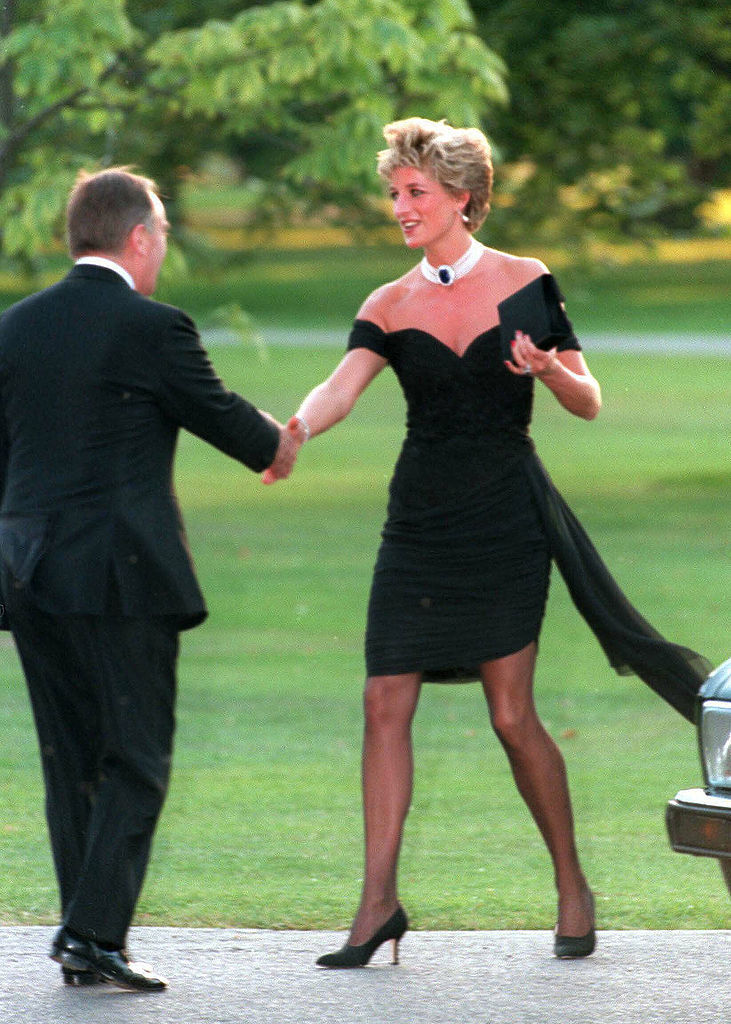Though Dominic West’s Prince Charles’ public admission of his affair with Camilla Parker Bowles is ostensibly the focus of the fifth installment of The Crown’s explosive fifth season, the episode’s most arresting moment has no dialogue, clocks in at just under 30 seconds—and doesn’t feature the newly-named King Charles III at all. Instead, the moment belongs to Elizabeth Debicki’s Princess Diana, who, though absent from most of this episode, steals the show when she emerges from a car in a recreation of the infamous “revenge dress”—a black dress that, in real life, made headlines everywhere 28 years ago when the actual Princess Di wore it to a highly photographed Vanity Fair party for the Serpentine Gallery in 1994 the same night Charles’ tell-all interview about his infidelity aired on television. With a single fashion statement, Diana eclipsed his confession.
The little black dress, a daring (at least by Royal Family standards) off-the-shoulder cocktail sheath by the Greek designer Christina Stambolian, has become the most enduring image of the Diana’s fight to live her life on her own terms. The wardrobe choice was certainly no coincidence; as Princess of Wales, Diana quickly realized the power of presentation. Under the Firm, she was subject to constant and intense public scrutiny, and was rarely afforded the chance to speak for herself—so the clothes she chose became her mode of expression. The dress, worn with sheer black hose, black pumps, a red manicure, and a pearl and sapphire choker necklace, sent a clear message that Diana was no tragic bystander in this messy situation, but instead, a powerful, resilient and beautiful woman who wasn’t going to sit at home wringing her hands as her adulterous husband’s dirty laundry aired in public.

Read More: As King Charles III Sets Out to Win Hearts and Minds, The Crown Dredges Up His Darkest Chapter
Diana was allegedly planning to wear a Valentino dress to the gala but made the last-minute decision to wear the figure-hugging black mini-dress. In an interview featured in Princess Diana’s Dresses: The Auction, a 2013 Channel 4 documentary, Stambolian revealed that Diana had actually bought the gown three years prior but had never worn it because she considered it too “daring,” but that in donning it that night, she “played it like Odile,” the antiheroine black swan from Swan Lake. In the same documentary, Diana’s stylist, former British Vogue editor Anna Harvey succinctly sums the motivation behind her change of heart: “Diana wanted to look a million dollars,” she explained. “And she did!”
In reclaiming her narrative by sporting her little black dress, Diana also veritably introduced the concept of the “revenge dress” into the zeitgeist. While the belief that looking good in spite of heartbreak is hardly new, Diana’s revenge dress crystallized the idea in pop culture that looking good could just be the best revenge. From Beyoncé, who penned her own ode to revenge dressing with “Freakum Dress” to Rihanna, who cited the Stambolian revenge dress as one of her style inspirations and crowned Diana a “bad bitch” in a 2017 interview with French Vogue, the revenge dress, much like Diana’s public persona itself, has loomed large in our collective imaginations long after the princess’ time in the spotlight.
Read More: The Crown Doesn’t Fully Explain Diana’s Popularity. Here’s How She Became a Global Celebrity
As for why the revenge dress and this revenge dress in particular, has had such staying power in culture, fashion historian and assistant curator of fashion for the Cleveland Museum of Art, Darnell-Jamal Lisby notes the qualities that made Diana so beloved as the People’s Princess: she may have been a royal with a seemingly fairy tale life, but she wasn’t immune to heartbreak or infidelity—struggles that nearly everyone could relate to.
“That [revenge dress] image resonates with us because we have deep feelings for Diana, for the pain that she was going through, so to see her have this victory in that moment, no matter how small it was, it actually becomes a big victory in our eyes,” Lisby tells TIME.
Per Lisby, Diana in the revenge dress has ultimately endured as one of her key looks because at its heart is another quality that endeared the princess to the public: vulnerability. In wearing the revenge dress, Diana not only acknowledged the pain she must have felt while Charles’ infidelity played out in public, but also kept an eye toward reclaiming her power and her future. It was a moment of claiming agency for herself by way of a little black dress.
Read More: The 7 Best Movies and TV Shows to Watch About Princess Diana
“She was showing the pain she was going through, but also that she was trying to find herself,” Lisby says. “By the time she was separating from Charles, she was a grown woman in the real world. The identity of the dress was very much, ‘I’m an independent individual and I’m out in these streets and I’m feeling myself.’”
More Must-Reads From TIME
- The 100 Most Influential People of 2024
- The Revolution of Yulia Navalnaya
- 6 Compliments That Land Every Time
- What's the Deal With the Bitcoin Halving?
- If You're Dating Right Now , You're Brave: Column
- The AI That Could Heal a Divided Internet
- Fallout Is a Brilliant Model for the Future of Video Game Adaptations
- Want Weekly Recs on What to Watch, Read, and More? Sign Up for Worth Your Time
Write to Cady Lang at cady.lang@timemagazine.com